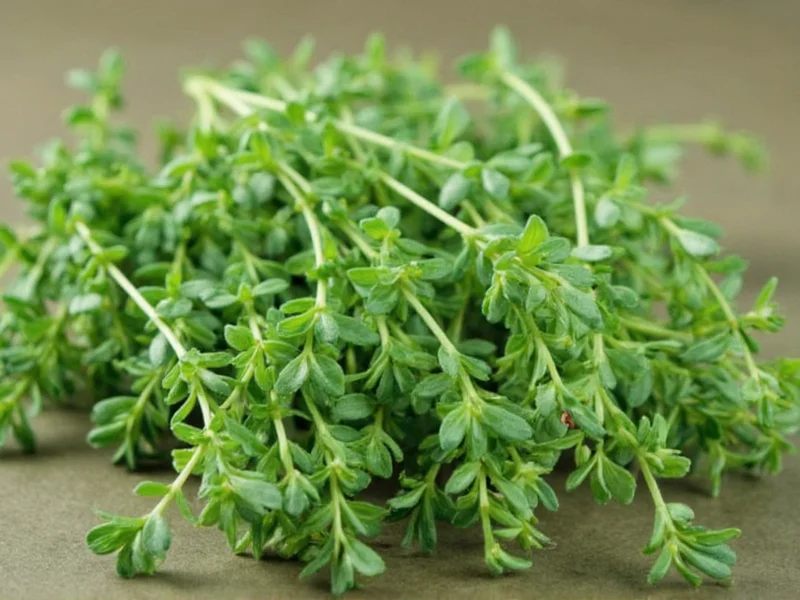Understanding what fresh thyme looks like is essential for home cooks and gardeners who want to select the best quality herb for their culinary creations. This versatile herb's appearance provides important clues about its freshness and flavor potential.
Physical Characteristics of Fresh Thyme
Fresh thyme has several distinctive visual features that help with identification. The herb grows in small clusters along thin, somewhat woody stems that range from green to brown depending on maturity. Each stem typically measures 6-12 inches in length when harvested for culinary use.
Leaf Structure and Color
The leaves of fresh thyme are the most recognizable feature. They're small, measuring approximately 3-8 millimeters in length, and grow in opposite pairs along the stem. The leaf shape is narrow and oval with a slight curve, resembling miniature pine needles. Color ranges from bright gray-green to deep olive green, with some varieties showing subtle silver or purple undertones.
When examining what does fresh thyme look like up close, you'll notice the leaves have a slightly fuzzy or downy texture on the surface. This fine hair helps the plant retain moisture in its native Mediterranean climate. The leaves grow perpendicular to the stem, creating a dense, bushy appearance rather than lying flat against the stem.
Flowers (When Present)
Mature thyme plants may produce tiny flowers that cluster at the stem tips. These flowers are typically lavender, pink, or white and measure about 2-4 mm in diameter. While edible, flowering thyme often has slightly less intense flavor in the leaves as the plant's energy goes toward flower production.
| Feature | Description | Why It Matters |
|---|---|---|
| Leaf Size | 3-8 mm long, narrow oval shape | Smaller leaves generally indicate younger, more tender growth with better flavor |
| Stem Texture | Firm, slightly woody but pliable | Indicates freshness; brittle stems suggest age or improper storage |
| Color | Vibrant gray-green to olive green | Dull or yellowing color indicates deterioration and loss of flavor compounds |
| Aroma | Strong herbal scent with citrus and earth notes | Faint aroma suggests old or improperly stored thyme with diminished flavor |
How to Identify Quality Fresh Thyme
When selecting fresh thyme at the grocery store or farmers market, knowing how to tell if thyme is fresh makes a significant difference in your cooking results. High-quality fresh thyme should exhibit these characteristics:
- Vibrant color - Look for consistent green tones without yellowing, browning, or black spots
- Firm stems - Stems should be flexible but not brittle; they shouldn't snap easily when bent
- No wilting - Leaves should appear perky, not limp or drooping
- Moisture level - Should feel slightly damp but not wet or slimy
- Strong aroma - Rub a leaf between your fingers; fresh thyme releases an immediate, potent fragrance
One practical test for freshness is the "snap test" - gently bend a stem. Fresh thyme will bend without breaking, while older, drier thyme will snap crisply. Avoid bundles with excessive leaf drop when handled, as this indicates the herb is past its prime.
How Fresh Thyme Differs From Similar Herbs
Many beginners confuse thyme with other common kitchen herbs. Understanding thyme plant identification helps prevent culinary mistakes:
Thyme vs. Oregano
While both belong to the mint family, they have distinct differences. Thyme leaves are significantly smaller (3-8 mm vs. oregano's 10-20 mm), more narrow, and grow in opposite pairs along the stem. Oregano leaves are broader, more rounded, and have a more pronounced veining pattern. Thyme stems are thinner and more woody compared to oregano's thicker, greener stems.
Thyme vs. Rosemary
Rosemary has much longer, needle-like leaves (15-30 mm) that grow in clusters along the stem rather than in pairs. Rosemary stems are noticeably thicker and more rigid. The scent is also different - rosemary has a stronger pine-like aroma, while thyme offers more complex citrus and earth notes.
Practical Tips for Using Fresh Thyme
Once you've correctly identified fresh thyme, proper handling preserves its flavor and appearance. When wondering what does thyme look like in the garden versus store-bought, note that garden-fresh thyme often has more vibrant color and stronger aroma due to minimal transit time.
For storage, treat fresh thyme like cut flowers: trim the stem ends, place in a small glass with water, and cover loosely with a plastic bag. Store in the refrigerator for up to two weeks. Alternatively, wrap in a slightly damp paper towel and place in a perforated plastic bag.
When preparing thyme for cooking, strip leaves from stems by holding the stem upside down and running your fingers from the top toward the base. The small leaves should easily detach. Whole sprigs can be added to soups and stews and removed before serving.
Seasonal Variations in Appearance
Fresh thyme's appearance changes slightly throughout the growing season. Early spring growth tends to be more tender with brighter green color, while summer thyme develops more woody stems and deeper green or gray-green leaves. In fall, some varieties may show subtle purple tones in the stems.
Understanding these seasonal variations helps when determining what color is fresh thyme at different times of year. The key indicator of quality remains consistent vibrant color and firm texture regardless of seasonal hue variations.











 浙公网安备
33010002000092号
浙公网安备
33010002000092号 浙B2-20120091-4
浙B2-20120091-4